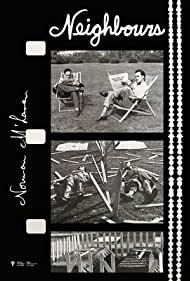Related Research Articles

William Norman McLaren, LL. D. was a Scottish Canadian animator, director and producer known for his work for the National Film Board of Canada (NFB). He was a pioneer in a number of areas of animation and filmmaking, including hand-drawn animation, drawn-on-film animation, visual music, abstract film, pixilation and graphical sound. McLaren was also an artist and printmaker, and explored his interest in dance in his films.
Roman Kroitor was a Canadian filmmaker who was known as a pioneer of Cinéma vérité, as the co-founder of IMAX, and as the creator of the Sandde hand-drawn stereoscopic 3D animation system. He was also the original inspiration for The Force. His prodigious output garnered numerous awards, including two BAFTA Awards, three Cannes Film Festival awards, and two Oscar nominations.

Ryan Larkin was a Canadian animator, artist, and sculptor who rose to fame with the psychedelic Oscar-nominated short Walking (1968) and the acclaimed Street Musique (1972). He was the subject of the Oscar-winning film Ryan.

Neighbours is a 1952 anti-war film by Scottish-Canadian filmmaker Norman McLaren for the National Film Board of Canada. In 1953, it won the Oscar for Best Documentary, Short Subject.
George Garnett Dunning was a Canadian filmmaker and animator. He is best known for producing and directing the 1968 film Yellow Submarine.
Narcissus is a 1983 Canadian short musical and experimental film directed by Norman McLaren and produced by David Verrall, visualizing the legend of Narcissus in a modern way. It was produced for the National Film Board of Canada.
Colin Archibald Low was a Canadian animation and documentary filmmaker with the National Film Board of Canada (NFB). He was known as a pioneer, one of Canada's most important filmmakers, and was regularly referred to as "the gentleman genius". His numerous honors include five BAFTA awards, eight Cannes Film Festival awards, and six Academy Award nominations.
Paddle to the Sea is a 1966 National Film Board of Canada short live-action film directed, shot and edited by Bill Mason. It is based on the 1941 children's book Paddle-to-the-Sea by American author and illustrator Holling C. Holling, and follows the adventures of a child's hand-carved toy Indian in a canoe as it makes its way from Lake Superior to the Gulf of Saint Lawrence, through Canada's waterways. It was nominated for an Academy Award for Best Live Action Short Film at the 40th Academy Awards.
Tony Ianzelo is a Canadian documentary director and cinematographer.
Hugh O'Connor was a Canadian director and producer who worked for the National Film Board of Canada (NFB). His best- known film is the ground-breaking In the Labyrinth (1967), but his promising career ended shortly after that film's release when he was murdered while filming in Kentucky.
Eskimo Artist: Kenojuak is a 1964 Canadian short film about Inuk artist Kenojuak Ashevak, directed by John Feeney and produced by the National Film Board of Canada (NFB). It won the BAFTA Award for Best Short Film in 1964 and, in 1965, was nominated for the Academy Award for Best Documentary Short Film.

Gerald Potterton was a Canadian director, animator, producer and writer. He is best known for directing the cult classic Heavy Metal and for his animation work on Yellow Submarine.
Evelyn Lambart was a Canadian animator and film director with the National Film Board of Canada, known for her independent work, and for her collaborations with Norman McLaren.

Thomas Cullen Daly was a Canadian film producer, film editor and film director, who was the head of Studio B at the National Film Board of Canada (NFB).

Joseph (Joe) Koenig is a Canadian filmmaker and entrepreneur who was the founder and president of Electronics Workbench.
John Kemeny was a Hungarian-Canadian film producer whom the Toronto Star called "the forgotten giant of Canadian film history and...the most successful producer in Canadian history." His production credits include The Apprenticeship of Duddy Kravitz, Atlantic City, and Quest for Fire.

Albert Kish was a Canadian documentarian/filmmaker.
Robert Verrall was a Canadian animator, director and film producer who worked for the National Film Board of Canada (NFB) from 1945 to 1987. Over the course of his career, his films garnered a BAFTA Award, prizes at the Cannes Film Festival and Venice Film Festival, and six Academy Award nominations.
Julian Biggs (1920–1972) was a director and producer with the National Film Board of Canada and its first Director of English Production. Over the course of his 20-year career, he created 146 films, two of which were nominated for Academy Awards. His film 23 Skidoo (1964) received two BAFTA nominations, including the BAFTA United Nations award.
Guy L. Coté PhD (1925–1994) was a Canadian filmmaker with the National Film Board of Canada. He was also founding president of the Canadian Federation of Film Societies, and co-founder of the Cinémathèque québécoise and the Montreal World Film Festival.
References
- ↑ Evans 1991, p. 157.
- ↑ "Pas de deux". onf-nfb.gc.ca. National Film Board of Canada. Retrieved 27 February 2023.
- ↑ Melnyk, George (2004). One Hundred Years of Canadian Cinema. University of Toronto Press. p. 72. ISBN 978-0-8020-8444-6.
- 1 2 Alain, Dubeau (2001). Guide to the Cinema(s) of Canada. Greenwood Press. p. 168. ISBN 978-0-313-29931-5.
- ↑ Classical ballet transforms into a dance of the surreal in this duet from 1968|Aeon
- ↑ CanadARThistories
- ↑ 1969|Oscars.org
- Collins, Maynard (1976). Norman McLaren (Canadian film series): Canadian Film Institute. ASIN B0006CVBIW